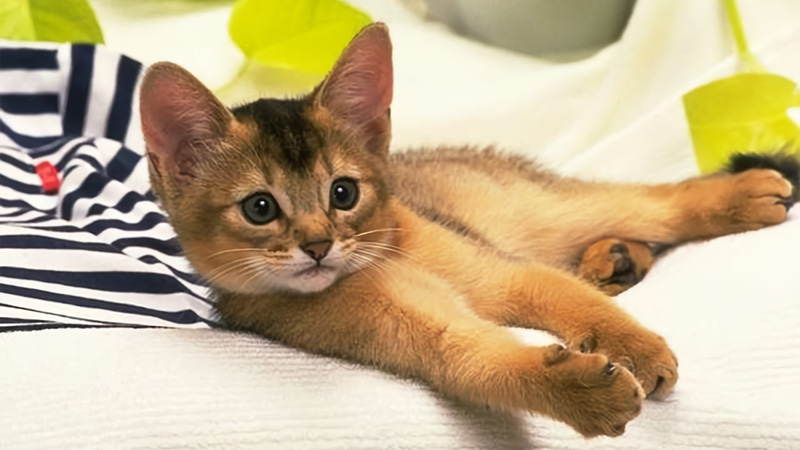When Can Cats Get Pregnant?

Puberty in cats is a pivotal phase that signifies the transition from playful kittenhood to the potential for reproduction. Unlike humans, feline puberty arrives at a relatively young age, and its timing is influenced by a medley of factors, including breed, genetics, and individual variances.
In this article, we will explore when cats can get pregnant, their reproductive cycle, and the signs of pregnancy.
Early-Maturing Breeds
Certain cat breeds are recognized for their early sexual maturity, a characteristic that may catch some cat owners off guard. Small or miniature breeds, exemplified by the Siamese or Abyssinian, are known to embark on their journey into puberty as early as 4 to 5 months of age. This swift transition from kittenhood to sexual maturity can surprise pet owners who may need to adapt to the changing needs and behaviors of their feline companions.
The Siamese, with its distinctive appearance and vocal nature, is often an early bloomer. Their small size and distinct genetic makeup contribute to their tendency to reach puberty sooner than some other breeds. Similarly, the Abyssinian, known for its playful demeanor and striking coat, may exhibit signs of sexual maturity as early as 4 to 5 months.
Standard Breeds
In contrast to their early-maturing counterparts, most standard-sized domestic cats, including mixed breeds, generally reach sexual maturity within the broader timeline of 5 to 9 months. This period allows for a more extended phase of kittenhood and playful exploration before entering the realm of adulthood.
However, it's crucial to recognize that even within standard breeds, individual cats within the same litter may experience puberty at different times. Genetics play a substantial role, and variations in the timing of sexual maturity among littermates are not uncommon. This diversity highlights the uniqueness of each feline's development, emphasizing the importance of individualized attention and care.
Factors Influencing Puberty in Cats
Several factors contribute to the onset and timing of puberty in cats:
Genetics:
Genetics play a fundamental role in determining when a cat reaches sexual maturity. Breeds with a predisposition for early or delayed maturation pass on these traits to their offspring.
Size and Breed Characteristics:
Smaller breeds, such as the Siamese, tend to mature earlier than larger breeds. The size and specific characteristics of a breed can influence the pace at which a cat transitions into puberty.
Environmental Factors:
The environment in which a cat is raised can also impact the timing of puberty. Factors such as nutrition, overall health, and exposure to other cats may contribute to the onset of sexual maturity.
Recognizing Puberty in Cats
Puberty in cats manifests through both behavioral and physical changes. Recognizing these signs can help cat owners navigate this transitional period:
Behavioral Changes:
Increased Vocalization: Cats may become more vocal, especially during the night, as they communicate their newfound reproductive status.
Restlessness and Agitation: Pubescent cats may display increased restlessness and agitation, seeking attention and exhibiting more active behavior.
Affectionate Behavior: Some cats become more affectionate, seeking additional attention from their owners during this hormonal shift.
Physical Changes:
Heat Cycles Begin: Female cats experience their first heat cycle, or estrus, marked by behavioral changes and physical signs like a swollen genital area.
Territorial Marking (in Males): Unneutered male cats may engage in territorial marking behaviors, such as spraying urine, as a response to hormonal changes.
Navigating Puberty Responsibly
Understanding the nuances of feline puberty empowers cat owners to provide appropriate care and address the changing needs of their pets. Early maturation in certain breeds necessitates vigilance in observing behavioral and physical changes. Additionally, responsible pet ownership often involves discussions with a veterinarian to determine the optimal time for spaying or neutering to prevent unintended pregnancies and contribute to the overall well-being of our feline companions.
In conclusion, feline puberty is a dynamic and transformative phase in a cat's life, influenced by a combination of genetic, environmental, and breed-specific factors. By recognizing the signs and understanding the individuality of each cat's development, pet owners can navigate this journey with sensitivity and provide the necessary support for their feline friends.
You May Also Like
 Cat HealthIs Neutering Painful For Cats
Cat HealthIs Neutering Painful For Cats Help & AdviceHow Do I Care For My Cat After Neutering
Help & AdviceHow Do I Care For My Cat After Neutering Help & AdviceHow Do I Know if My Cat Needs to be Neutered?
Help & AdviceHow Do I Know if My Cat Needs to be Neutered? Cat HealthWhat Is The Best Age To Spay Or Neuter A Cat?
Cat HealthWhat Is The Best Age To Spay Or Neuter A Cat? Help & AdviceTo Keep Your Cat Live Longer, These 8 Factors Must Be Paid Attention To
Help & AdviceTo Keep Your Cat Live Longer, These 8 Factors Must Be Paid Attention To Breed ReviewsThe 6 Disadvantages of Male Cats, Can You Accept Them?
Breed ReviewsThe 6 Disadvantages of Male Cats, Can You Accept Them?